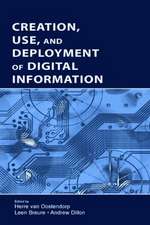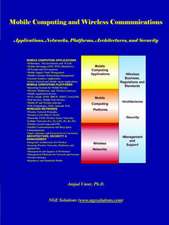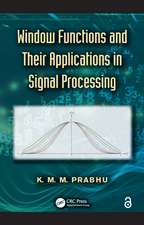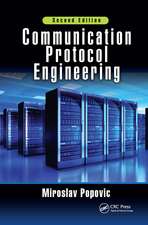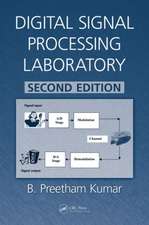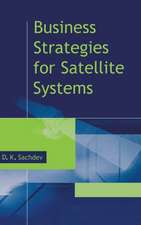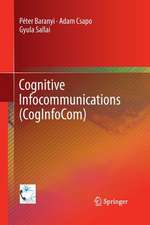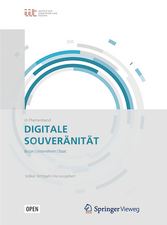Communications System Laboratory
Autor B. Preetham Kumaren Limba Engleză Paperback – 31 mar 2021
The book merges theory with practical software and hardware applications. Each chapter includes the following components: a brief theory that describes the underlying mathematics and principles, a problem-solving section with a set of typical problems, a computer laboratory with programming examples and exercises in MATLAB® and Simulink®, and finally, in applicable chapters, a hardware laboratory with exercises using test and measurement equipment.
Covering fundamental topics such as frequency and bandwidth, as well as different generations of modulation including current 4G long-term evolution (LTE) techniques and future technologies like ultra wideband (UWB) systems, Communications System Laboratory provides engineering students with a deeper understanding of how electronic communications link the world.
| Toate formatele și edițiile | Preț | Express |
|---|---|---|
| Paperback (1) | 442.50 lei 6-8 săpt. | |
| CRC Press – 31 mar 2021 | 442.50 lei 6-8 săpt. | |
| Hardback (1) | 680.59 lei 6-8 săpt. | |
| CRC Press – 23 oct 2015 | 680.59 lei 6-8 săpt. |
Preț: 442.50 lei
Nou
Puncte Express: 664
Preț estimativ în valută:
84.67€ • 88.59$ • 70.34£
84.67€ • 88.59$ • 70.34£
Carte tipărită la comandă
Livrare economică 02-16 aprilie
Preluare comenzi: 021 569.72.76
Specificații
ISBN-13: 9780367783341
ISBN-10: 0367783347
Pagini: 440
Dimensiuni: 156 x 234 x 23 mm
Greutate: 0.6 kg
Ediția:1
Editura: CRC Press
Colecția CRC Press
Locul publicării:Boca Raton, United States
ISBN-10: 0367783347
Pagini: 440
Dimensiuni: 156 x 234 x 23 mm
Greutate: 0.6 kg
Ediția:1
Editura: CRC Press
Colecția CRC Press
Locul publicării:Boca Raton, United States
Cuprins
Types of Electronic Communication Systems. Time/Frequency Analysis of Communication Signals and Systems. First-Generation Systems: Analog Modulation. Second-Generation Systems: Digital Modulation. Third-Generation Systems: Wideband Digital Modulation. Capacity of Communication Systems and Higher Generations. Long-Range and Short-Range Communication Networks. Appendix A: Synthesized Waveform Generators. Appendix B: RF Spectrum Analyzers. Appendix C: Dynamic Signal Analyzers. Appendix D: Digital Storage Oscilloscopes. Appendix E: Integrated Circuits for Communication Systems. Appendix F: Worldwide Frequency Bands and Terminology.
Notă biografică
B. Preetham Kumar holds a BE and ME from the College of Engineering, Chennai, India, and a Ph.D from the Indian Institute of Technology, Chennai. He is professor and graduate coordinator in the Department of Electrical and Electronic Engineering at California State University (CSUS), Sacramento, USA. Previously, he was part-time faculty at CSUS, and researcher/lecturer in the RF and Microwave Laboratory at University of California, Davis, USA. Widely published and highly decorated, Dr. Kumar has worked on projects funded by Lockheed Martin, Agilent Technologies, National Semiconductor, Intel, and Antenna Wireless, Inc. Currently, he is heading an effort to expand the use of microwave heating in the treatment of cancer.
Recenzii
"… suitable for electronic engineering students and young researchers to build up their initial knowledge in communications system analysis and design. … provides an insightful overview of the communications system’s structure, hierarchy, requirement identification, analysis, and performance evaluation. The main distinguishing point of this book is a great and well-structured offer of MATLAB® exercises associated to each communications system component design. Such an approach enables beginners, such as undergraduate or postgraduate students, to easily develop their experience and understanding of mutual relations and interdependencies of various communications system factors. It also facilitates quick development of MATLAB® simulations for designing and evaluating communications systems in realistic environments."
—Dr. Vladan Velisavljevic, University of Bedfordshire, Luton, UK
—Dr. Vladan Velisavljevic, University of Bedfordshire, Luton, UK
Descriere
This book offers an integrated approach, combining theory, simulation using computer tools, and experimental practice using hardware. Each chapter includes the following components: a brief theory that describes the underlying mathematics and principles, a problem-solving section with a set of typical problems, a computer laboratory with program





